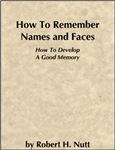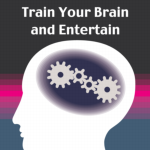Published on Friday, October 19, 2007 in
books,
fun,
memory,
memory feats,
products,
psychology
 Once people start training their memories, they often try the techniques out by remembering standard things, like memorizing the U.S. States and their capitals, a new language or the U.S. Presidents. But what are some of the more unusual things that are fun and/or useful to remember?
Once people start training their memories, they often try the techniques out by remembering standard things, like memorizing the U.S. States and their capitals, a new language or the U.S. Presidents. But what are some of the more unusual things that are fun and/or useful to remember?
You've probably heard about Scrabble players who memorize word lists, but there is another way to use memory in Scrabble. Imagine you have the letters for TSUNAMI on your rack, and there's a spot with room for all 7 letters, but it would force you to use the letter H. Could it be done? If you knew your Anamonics (a combination of the word anagram and mnemonics) you could tell instantly. If you remembered the word TSUNAMI in connection with the phrase COASTAL HARM, you could instantly see that you could use the H, because it's among the letters in COASTAL HARM. Armed with your knowledge of words, you could figure out that you could make the word HUMANIST from those letters, and maximize your score. You would also know that, given the letters of TSUNAMI and the letter B, you shouldn't waste your time trying to use all the letters on your board. John Chew maintains a thorough list of anamonics that is popular with Scrabble players.
All this talk of word lists brings to mind an anecdote from chapter 16 of The Memory Book, by Harry Lorayne and Jerry Lucas. Harry says the word ARTERIOSCLEROSIS and Jerry immediately replies, “ACEEIILOORRRSSST!” In other words, Jerry Lucas is able to instantly alphabetize the letters of any word. He uses a simple adaption of the Link System. For example, if you're trying to remember that the alphabetical order of letters in TELEPHONE is EEEHLNOPT, you would simply picture an eel that napped on telephone. Eel napped sounds enough like EEEHLNOPT that the letter should come to mind quickly.
Memorizing a word list such as this would seem to be quite intimidating, and it would be over just a few sittings. If you wanted to actually try your hand at this memory feat, you should first realize that this is a skill you would develop over the long term. As a matter of fact, Jerry Lucas started doing this when he was 8! The best way to start is to work with lists of common words. First, learn and link the alphabetical spellings of the 100 most common words in the English language (or whichever language you speak). Once you've memorized them, go on to the second most common 100 words, then the third, and so on. By the time you get the most common 300 words down, you've already got roughly a 65% chance of being able to alphabetize a word randomly chosen out of a non-technical book or magazine!
An unusual. but more personable. list to learn would be one or more historical event or famous person's birthday for each day of the year. You would remember each date as a 3- or 4-digit number (January 5th would be 105, while November 21st would be 1121). First, look up the event or birthday, and find a well-known person or event (the more famous the better). There were many famous people born on January 1st, but more people will be familiar with Frank Langella or Betsy Ross than, say, Huldrych Zwingli or Charles Melvin Price.
Once you'ce decided that you're going to remember that January 1st is the birthday of Frank Langella, use the peg system to convert 101 (January 1st) into a word, such as dust or taste. Since Frank Langella is best known for his role as Dracula, taste would probably be a good choice. Picture Frank Langella's Dracula tasting his victims, and you've got the image!
The best thing about this last feat is that it can really help you connect with people, and shows that you're listening. If someone says they were born on January 12th, you can instantly say, “Oh! You have the same birthday as Jack London!” It would also work during the Day of the Week for any Date feat.
To wrap this up, I'll leave you with the case of David Rosdeitcher, who has actually made a living based largely on his particular brand of unusual knowledge.

 There's some interesting news coming across the wires about the modern American memory. According to a Kelton Research survey, more Americans can name the ingredients of a McDonald's Big Mac than can name the 10 commandments.
There's some interesting news coming across the wires about the modern American memory. According to a Kelton Research survey, more Americans can name the ingredients of a McDonald's Big Mac than can name the 10 commandments.




 Once people start training their memories, they often try the techniques out by remembering standard things, like memorizing the
Once people start training their memories, they often try the techniques out by remembering standard things, like memorizing the 
 By far, the most popular item in the
By far, the most popular item in the  It's time to challenge your memory again!
It's time to challenge your memory again!

